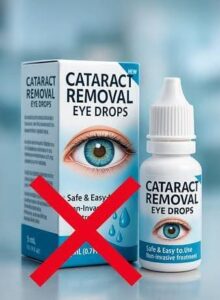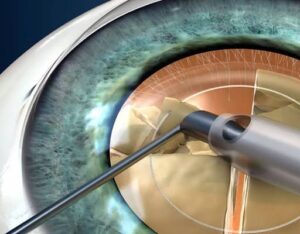Cataracts are a common eye condition where the natural lens becomes cloudy, leading to blurry vision. While mostly age-related, cataracts can affect anyone and often develop gradually over time.
Source: Autumn Sprabary
What Causes Cataracts?
Cataracts form when proteins in the eye’s lens break down and clump together. Common causes include:
- Aging
- UV radiation from sunlight or artificial sources
- Oxidative stress (smoking)
- Diabetes
- Eye or head injury
- Prolonged steroid use
Types of Cataracts
Cataracts can be classified depending on the location where they form, for example:
- Nuclear – Central part of the lens, yellows over time
- Cortical – Edge-based spokes moving inward
- Posterior Subcapsular – Back of the lens

Source: Eyeguru
Can Cataracts Go Away on Their Own?
Unfortunately, cataracts do not go away or reverse on their own as it is a physical change to the lens itself. Once the lens becomes cloudy, it cannot return to being clear. No eye drops, diet changes, supplements or exercises have been proven to reverse or “cure” cataracts.

How About Delaying It?
While there are no proven methods to reverse or cure cataract without surgery, certain habits may help slow their progression:
- Wear UV-protective sunglasses – Ultraviolet (UV) light from the sun can damage the lens over time.
- Avoid smoking – Smoking increases the risk of cataracts. Quitting can benefit your eyes and overall health.
- Manage health conditions – Conditions like diabetes and high blood pressure can speed up cataract formation.
- Use protective eyewear – If you work with chemicals or in environments where eye injuries are possible, safety glasses can prevent lens damage.
- Have regular eye exams – Detecting early changes allows for better management and timely advice.
When Should You Consider Surgery?
If cataracts are affecting your ability to read, drive, or do daily tasks, it may be time to talk to your eye specialist about surgery. The good news is that cataract surgery is highly successful, quick (often under 20 minutes), and requires minimal recovery time.
If you have certain medical conditions, such as diabetes or high blood pressure, your eye specialist may put you on a treatment plan to control your condition before your cataract surgery, so that the surgery can proceed without added risks during or after the surgery.
Treating Cataracts
The only definitive and effective treatment for a cataract is surgery. Known as phacoemulsification, this procedure involves the use of ultrasonic waves to break the cataract into small fragments, which are subsequently suctioned out of the eye through a small incision.

Source: Roque
After the cataract is removed, a clear intraocular lens (IOL) is implanted into the lens capsule to restore vision. This is a safe and common procedure that usually takes about 20 minutes. IOL can be divided into 3 groups:
- Monofocal IOL – Clear distance vision; reading glasses needed
- Extended Depth of Focus (EDOF) IOL – Smooth focus across distances and intermediate
- Multifocal IOL – Seamless transition between distance, intermediate and near

The selection of IOL is based on one’s visual demand and eye condition.
Post-Surgery Care Tips
After surgery, proper care is crucial for healing:
- No heavy lifting or bending over
- Use an eye shield, wear sunglasses, avoid rubbing
- Use prescribed drops on time
- Attend follow-up visits
- Avoid swimming, eye makeup, or dusty environments
- Call your doctor if you notice pain, redness, vision changes, or discharge.
Conclusion
If cataracts are impacting your quality of life, the safest and most effective solution is to talk to an ophthalmologist about cataract surgery. It’s a life-changing procedure that can restore your vision and help you get back to doing the things you love. There is no way to remove cataracts without surgery. While glasses or better lighting can help temporarily, the only proven treatment to restore clear vision is cataract surgery.
If you suspect yourself of having a cataract or notice changes in your vision, see an eye specialist for a proper diagnosis and advice.
FAQs
Lorem ipsum dolor sit amet, consectetur adipiscing elit. Ut elit tellus, luctus nec ullamcorper mattis, pulvinar dapibus leo.
Lorem ipsum dolor sit amet, consectetur adipiscing elit. Ut elit tellus, luctus nec ullamcorper mattis, pulvinar dapibus leo.







